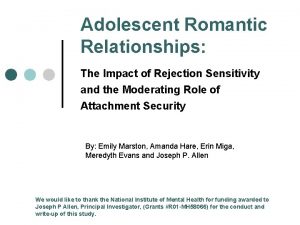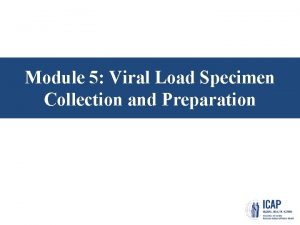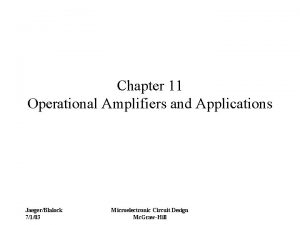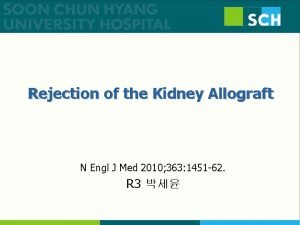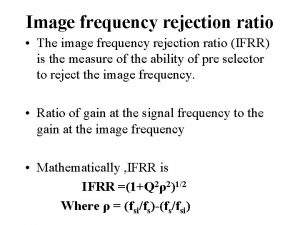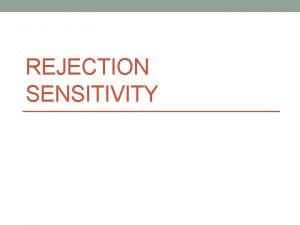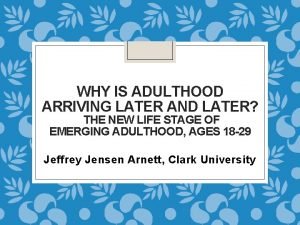Adolescent Attachment to Parents Predicting Later Adolescent Rejection
















- Slides: 16

Adolescent Attachment to Parents: Predicting Later Adolescent Rejection Sensitivity I would like to thank the William T. Grant Foundation, Spencer Foundation, and National Institute of Mental Health for funding provided to Dr. Joseph Allen, Principal Investigator, for the conduct and write-up of this study. The author can be reached at: Martin J. Ho University of Denver Frontier Hall, Dept. of Psychology 2125 S. Race Street Denver, Colorado 80208 mho 2@du. edu

Attachment Relationships • Parent-child relationships and romantic relationships have been framed within the attachment perspective (Hazan & Shaver, 1987). For example, adult romantic relationships may provide romantic partners with a secure base and safe haven based off the parent-child attachment model.

Attachment Relationships Cont’d • Researchers on adolescent romantic relationships have suggested a hierarchically organized view of adolescent romantic relationships, where adolescents’ views toward romantic partners are part of a general representation of relationships toward parents, peers, and past and present romantic partners (Furman & Simon, 1999; Collins & Reed, 1994).

Rejection Sensitivity • The cognitive-affective processing system of rejection sensitivity draws too on the attachment perspective (Downey, Bonica, & Rincon, 1999). Individuals who are more rejection sensitive—those who anxiously or angrily expect, readily perceive, and react intensely to rejection— are vulnerable to perceiving and thus experiencing rejection in their relationships.

Rejection Sensitivity Cont’d • Within the context of adolescent romantic relationships, highly rejection sensitive adolescents may limit involvement and investment in romantic relationships. That is, rejection sensitivity can be seen as having an impact on the development of romantic relationships in adolescents. Taken further, experiences of rejection from parent and peer relationships can be seen as influencing adolescents’ levels of rejection sensitivity.

Current Study • From the attachment perspective, adolescents who perceive less attachment to parents and peers are more likely to develop higher levels of rejection sensitivity. The current study uses hierarchical regression analysis and latent growth curve modeling to explore links between adolescent attachment to parents and adolescent rejection sensitivity.

Method • Participants – Data were collected from 185 adolescents recruited through a public school (52% male, 39% minority, median family income $50, 000). Adolescents were followed four years assessed annually (age range 13 -17). • Rejection Sensitivity Questionnaire (RSQ) – Assessed at the fourth wave of study and scored according to the guidelines developed by Downey & Feldman (1996), the RSQ is an 18 -item self-report measure assessing adolescents’ level of rejection sensitivity.

Method • Rejection Sensitivity Questionnaire (RSQ) cont’d – Scenarios are rated on two dimensions: • the degree of anxiety or concern about the outcome • the expectations of acceptance or rejection. • Inventory of Parent and Peer Attachment (IPPA) – Assessed at age 13, adolescents’ attachment to parents was assessed. The IPPA (Armsden & Greenberg, 1987) is a twenty-five item self-report measure assessing adolescents’ perceptions of how well their parents serve as a source of psychological security.

Table 1. Correlations Attachment to Mom Time 1 Attachment to Mom Time 2 Attachment to Mom Time 3 Attachment to Dad Time 1 Attachment to Dad Time 2 Attachment to Dad Time 3 Adolescent Rejection Sensitivity 1. 00 . 55*** . 51*** . 60*** . 33*** -. 16** 1. 00 . 67*** . 39*** . 62*** . 53*** -. 16** 1. 00 . 40*** . 47*** . 63*** -. 24** 1. 00 . 61*** . 55*** -. 22** 1. 00 . 75*** -. 26** 1. 00 -. 23** Attachment to Mom Time 3 Attachment to Dad Time 1 Attachment to Dad Time 2 Attachment to Dad Time 3 Adolescent Rejection Sensitivity Note. *** p <. 001; ** p <. 01; * p <. 05; n=101 -155. 1. 00

Table 2. Hierarchical Regressions Step I. Gender Minority Step II. Attachment to mom at time 1 Step II. Attachment to mom at time 2 Step II. Attachment to mom at time 3 Step II. Attachment to dad at time 1 Step II. Attachment to dad at time 2 Step II. Attachment to dad at time 3 β Total R 2 ΔR 2 -. 17** -. 14** -. 13** -. 20** -. 21** -. 20** -. 34** -. 24** . 05** . 06** . 11** . 10** . 14** . 11** . 06** . 05** . 09** . 06**

Results • Adolescent reports of attachment to mothers are highly related to reports of attachment to fathers (r=. 33 -. 75, p<. 001, see Table 1). • Higher levels of reported attachment to mothers and fathers are related to lower levels of adolescent rejection sensitivity. Adolescent reports of rejection sensitivity are related to reported attachment to mothers at time 3 but related to reported attachment to fathers at time 1 -3. • Hierarchical regression analyses reveal similar trends. There were no gender or minority interactions with predicting adolescent rejection sensitivity.

Figure 1. Latent Growth Curve Model of Attachment to Mothers Predicting Adolescent Rejection Sensitivity 1. 0 0 . 63 -. 22* χ2 = 2. 0 (. 373) df = 2 RMSEA =. 000 -. 19 1. 0

Figure 2. Latent Growth Curve Model of Attachment to Father Predicting Adolescent Rejection Sensitivity 1. 0 0 . 69 -. 09 -. 13 χ2 = 0. 6 (. 728) df = 2 RMSEA =. 000 -. 28** 1. 0

Results • SEM was used to predict adolescent rejection sensitivity from both mean levels (intercept) and changes (slopes) in adolescent attachment to mothers and fathers. See Figures 1 and 2. • Change in attachment to fathers was predictive of adolescent levels of rejection sensitivity (β=-. 28, P<. 01). That is, increases in levels of attachment to fathers is predictive of lower levels of rejection sensitivity. • Change in attachment to mothers was not predictive of adolescent levels of rejection sensitivity; however, mean levels was significantly related (β=-. 22, P<. 05). That is, higher average levels of attachment to mothers is predictive of lower levels of rejection sensitivity.

Conclusion • Parent-child relationships clearly play a role in developing adolescent romantic relationships. • The associations between adolescents’ attachment to parents and their rejection sensitivities suggest that the quality of relationships between parents and adolescents is important toward developing views for adolescents on romantic relationships. • Further studies will be conducted to assess the degree to which rejection sensitivity impacts an adolescent’s decision to engage in romantic relationships. • Additionally, studies will be conducted on the relationship between adolescent rejection sensitivity and attachment to parents as assessed by the AAI.

Conclusion • Preliminary findings from modeling change in adolescent attachment to mothers and fathers highlight the importance of assessing both intraindividual change alongside interpersonal differences. • Interestingly, changes in attachment to fathers, and not mothers, is predictive of adolescent rejection sensitivity. This highlights the importance of paternal relationships throughout adolescence and its role in developing adolescent romantic relationships.
 Rejection attachment
Rejection attachment Parents parents
Parents parents Frida kahlo famille arbre généalogique
Frida kahlo famille arbre généalogique Frida kahlo mes grands-parents mes parents et moi 1936
Frida kahlo mes grands-parents mes parents et moi 1936 When blood sample hemolyzed
When blood sample hemolyzed Chronic rejection
Chronic rejection Test management activities
Test management activities Name
Name Sample rejection criteria
Sample rejection criteria Chronic rejection
Chronic rejection Paraprashing
Paraprashing Chronic rejection
Chronic rejection Dependency rejection
Dependency rejection Voltage gain of amplifier
Voltage gain of amplifier Sample rejection criteria
Sample rejection criteria Chronic rejection
Chronic rejection Chronic rejection
Chronic rejection
